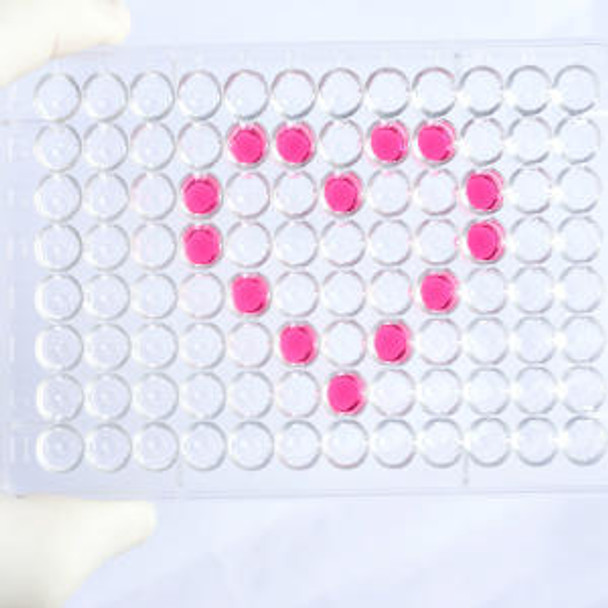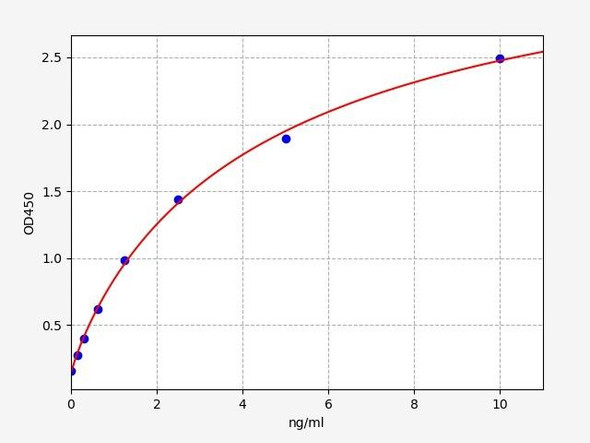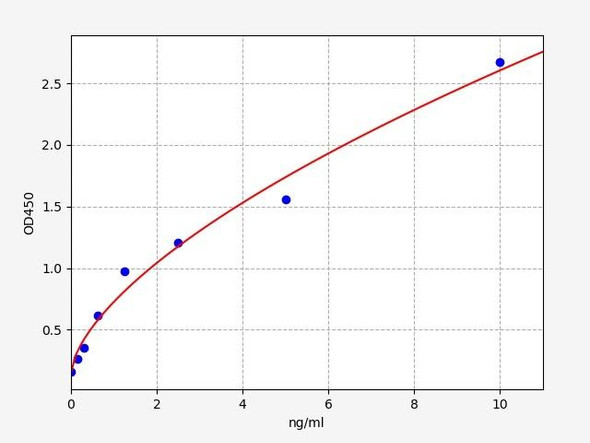Human Retinoic acid receptor alpha (RARA) ELISA Kit
- SKU:
- HUEB2335
- Product Type:
- ELISA Kit
- Size:
- 96 Assays
- Uniprot:
- P10276
- Range:
- 0.312-20 ng/mL
- ELISA Type:
- Sandwich
- Synonyms:
- RARalpha, RARA, NR1B1, RARA, alpha polypeptide, RAR-alpha, retinoic acid receptor, alpha, RAR, NR1B1, Nuclear receptor subfamily 1 group B member 1, NR1B1
- Reactivity:
- Human
Description
| Product Name: | Human Retinoic acid receptor alpha (RARA) ELISA Kit |
| Product Code: | HUEB2335 |
| Alias: | Retinoic acid receptor alpha, RAR-alpha, Nuclear receptor subfamily 1 group B member 1, RARA, NR1B1 |
| Uniprot: | P10276 |
| Reactivity: | Human |
| Range: | 0.312-20 ng/mL |
| Detection Method: | Sandwich |
| Size: | 96 Assay |
| Storage: | Please see kit components below for exact storage details |
| Note: | For research use only |
| UniProt Protein Function: | RARA: is a receptor for retinoic acid, a potent mammalian morphogen and teratogen that has profound effects on vertebrate development. RARA is a member of the nuclear receptor superfamily. Controls cell function by directly regulating gene expression. Its phosphorylation is crucial for transcriptional activity. Aberrations involving RARA may be a cause of acute promyelocytic leukemia. Two splice-variant isoforms have been described. |
| UniProt Protein Details: | Protein type:DNA-binding; Oncoprotein; Transcription factor; Nuclear receptor Chromosomal Location of Human Ortholog: 17q21 Cellular Component: nucleoplasm; cell surface; cell soma; perinuclear region of cytoplasm; cytoplasm; dendrite; nuclear chromatin; nucleus; actin cytoskeleton Molecular Function:protein domain specific binding; protein kinase B binding; retinoic acid binding; zinc ion binding; chromatin DNA binding; translation repressor activity, nucleic acid binding; transcription coactivator activity; phosphoinositide 3-kinase regulator activity; drug binding; alpha-actinin binding; transcription factor binding; protein binding; enzyme binding; protein heterodimerization activity; protein kinase A binding; steroid hormone receptor activity; mRNA 5'-UTR binding; retinoic acid receptor activity; transcription factor activity; transcription corepressor activity; receptor binding Biological Process: retinoic acid receptor signaling pathway; limb development; prostate gland development; negative regulation of translational initiation; regulation of myelination; estrogen receptor signaling pathway; glandular epithelial cell development; positive regulation of transcription, DNA-dependent; ventricular cardiac muscle cell differentiation; regulation of synaptic plasticity; female pregnancy; negative regulation of transcription from RNA polymerase II promoter; signal transduction; protein amino acid phosphorylation; regulation of phosphoinositide 3-kinase activity; response to estradiol stimulus; response to vitamin A; negative regulation of granulocyte differentiation; germ cell development; positive regulation of interleukin-4 production; negative regulation of cell proliferation; Sertoli cell fate commitment; positive regulation of T-helper 2 cell differentiation; ureteric bud development; negative regulation of interferon-gamma production; positive regulation of cell proliferation; positive regulation of interleukin-13 production; transmembrane transport; positive regulation of interleukin-5 production; transcription initiation from RNA polymerase II promoter; response to retinoic acid; multicellular organism growth; positive regulation of cell cycle; positive regulation of binding; negative regulation of tumor necrosis factor production; liver development; embryonic camera-type eye development; positive regulation of phosphoinositide 3-kinase cascade; positive regulation of protein kinase B signaling cascade; response to ethanol; response to cytokine stimulus; neural tube closure; gene expression; spermatogenesis; positive regulation of transcription from RNA polymerase II promoter; steroid hormone mediated signaling; positive regulation of neuron differentiation; negative regulation of transcription, DNA-dependent; apoptotic cell clearance; negative regulation of apoptosis Disease: Acute Promyelocytic Leukemia |
| NCBI Summary: | This gene represents a nuclear retinoic acid receptor. The encoded protein, retinoic acid receptor alpha, regulates transcription in a ligand-dependent manner. This gene has been implicated in regulation of development, differentiation, apoptosis, granulopoeisis, and transcription of clock genes. Translocations between this locus and several other loci have been associated with acute promyelocytic leukemia. Alternatively spliced transcript variants have been found for this locus.[provided by RefSeq, Sep 2010] |
| UniProt Code: | P10276 |
| NCBI GenInfo Identifier: | 133483 |
| NCBI Gene ID: | 5914 |
| NCBI Accession: | P10276.2 |
| UniProt Secondary Accession: | P10276,P78456, Q13440, Q13441, Q96S41, Q9NQS0, B8Y636 |
| UniProt Related Accession: | P10276 |
| Molecular Weight: | 39,700 Da |
| NCBI Full Name: | Retinoic acid receptor alpha |
| NCBI Synonym Full Names: | retinoic acid receptor, alpha |
| NCBI Official Symbol: | RARA |
| NCBI Official Synonym Symbols: | RAR; NR1B1 |
| NCBI Protein Information: | retinoic acid receptor alpha; RAR-alpha; retinoic acid receptor, alpha polypeptide; nuclear receptor subfamily 1 group B member 1; retinoic acid nuclear receptor alpha variant 1; retinoic acid nuclear receptor alpha variant 2; nucleophosmin-retinoic acid receptor alpha fusion protein NPM-RAR long form |
| UniProt Protein Name: | Retinoic acid receptor alpha |
| UniProt Synonym Protein Names: | Nuclear receptor subfamily 1 group B member 1 |
| Protein Family: | Retinoic acid receptor |
| UniProt Gene Name: | RARA |
| UniProt Entry Name: | RARA_HUMAN |
| Component | Quantity (96 Assays) | Storage |
| ELISA Microplate (Dismountable) | 8×12 strips | -20°C |
| Lyophilized Standard | 2 | -20°C |
| Sample Diluent | 20ml | -20°C |
| Assay Diluent A | 10mL | -20°C |
| Assay Diluent B | 10mL | -20°C |
| Detection Reagent A | 120µL | -20°C |
| Detection Reagent B | 120µL | -20°C |
| Wash Buffer | 30mL | 4°C |
| Substrate | 10mL | 4°C |
| Stop Solution | 10mL | 4°C |
| Plate Sealer | 5 | - |
Other materials and equipment required:
- Microplate reader with 450 nm wavelength filter
- Multichannel Pipette, Pipette, microcentrifuge tubes and disposable pipette tips
- Incubator
- Deionized or distilled water
- Absorbent paper
- Buffer resevoir
*Note: The below protocol is a sample protocol. Protocols are specific to each batch/lot. For the correct instructions please follow the protocol included in your kit.
Allow all reagents to reach room temperature (Please do not dissolve the reagents at 37°C directly). All the reagents should be mixed thoroughly by gently swirling before pipetting. Avoid foaming. Keep appropriate numbers of strips for 1 experiment and remove extra strips from microtiter plate. Removed strips should be resealed and stored at -20°C until the kits expiry date. Prepare all reagents, working standards and samples as directed in the previous sections. Please predict the concentration before assaying. If values for these are not within the range of the standard curve, users must determine the optimal sample dilutions for their experiments. We recommend running all samples in duplicate.
| Step | |
| 1. | Add Sample: Add 100µL of Standard, Blank, or Sample per well. The blank well is added with Sample diluent. Solutions are added to the bottom of micro ELISA plate well, avoid inside wall touching and foaming as possible. Mix it gently. Cover the plate with sealer we provided. Incubate for 120 minutes at 37°C. |
| 2. | Remove the liquid from each well, don't wash. Add 100µL of Detection Reagent A working solution to each well. Cover with the Plate sealer. Gently tap the plate to ensure thorough mixing. Incubate for 1 hour at 37°C. Note: if Detection Reagent A appears cloudy warm to room temperature until solution is uniform. |
| 3. | Aspirate each well and wash, repeating the process three times. Wash by filling each well with Wash Buffer (approximately 400µL) (a squirt bottle, multi-channel pipette,manifold dispenser or automated washer are needed). Complete removal of liquid at each step is essential. After the last wash, completely remove remaining Wash Buffer by aspirating or decanting. Invert the plate and pat it against thick clean absorbent paper. |
| 4. | Add 100µL of Detection Reagent B working solution to each well. Cover with the Plate sealer. Incubate for 60 minutes at 37°C. |
| 5. | Repeat the wash process for five times as conducted in step 3. |
| 6. | Add 90µL of Substrate Solution to each well. Cover with a new Plate sealer and incubate for 10-20 minutes at 37°C. Protect the plate from light. The reaction time can be shortened or extended according to the actual color change, but this should not exceed more than 30 minutes. When apparent gradient appears in standard wells, user should terminatethe reaction. |
| 7. | Add 50µL of Stop Solution to each well. If color change does not appear uniform, gently tap the plate to ensure thorough mixing. |
| 8. | Determine the optical density (OD value) of each well at once, using a micro-plate reader set to 450 nm. User should open the micro-plate reader in advance, preheat the instrument, and set the testing parameters. |
| 9. | After experiment, store all reagents according to the specified storage temperature respectively until their expiry. |
When carrying out an ELISA assay it is important to prepare your samples in order to achieve the best possible results. Below we have a list of procedures for the preparation of samples for different sample types.
| Sample Type | Protocol |
| Serum | If using serum separator tubes, allow samples to clot for 30 minutes at room temperature. Centrifuge for 10 minutes at 1,000x g. Collect the serum fraction and assay promptly or aliquot and store the samples at -80°C. Avoid multiple freeze-thaw cycles. If serum separator tubes are not being used, allow samples to clot overnight at 2-8°C. Centrifuge for 10 minutes at 1,000x g. Remove serum and assay promptly or aliquot and store the samples at -80°C. Avoid multiple freeze-thaw cycles. |
| Plasma | Collect plasma using EDTA or heparin as an anticoagulant. Centrifuge samples at 4°C for 15 mins at 1000 × g within 30 mins of collection. Collect the plasma fraction and assay promptly or aliquot and store the samples at -80°C. Avoid multiple freeze-thaw cycles. Note: Over haemolysed samples are not suitable for use with this kit. |
| Urine & Cerebrospinal Fluid | Collect the urine (mid-stream) in a sterile container, centrifuge for 20 mins at 2000-3000 rpm. Remove supernatant and assay immediately. If any precipitation is detected, repeat the centrifugation step. A similar protocol can be used for cerebrospinal fluid. |
| Cell culture supernatant | Collect the cell culture media by pipette, followed by centrifugation at 4°C for 20 mins at 1500 rpm. Collect the clear supernatant and assay immediately. |
| Cell lysates | Solubilize cells in lysis buffer and allow to sit on ice for 30 minutes. Centrifuge tubes at 14,000 x g for 5 minutes to remove insoluble material. Aliquot the supernatant into a new tube and discard the remaining whole cell extract. Quantify total protein concentration using a total protein assay. Assay immediately or aliquot and store at ≤ -20 °C. |
| Tissue homogenates | The preparation of tissue homogenates will vary depending upon tissue type. Rinse tissue with 1X PBS to remove excess blood & homogenize in 20ml of 1X PBS (including protease inhibitors) and store overnight at ≤ -20°C. Two freeze-thaw cycles are required to break the cell membranes. To further disrupt the cell membranes you can sonicate the samples. Centrifuge homogenates for 5 mins at 5000xg. Remove the supernatant and assay immediately or aliquot and store at -20°C or -80°C. |
| Tissue lysates | Rinse tissue with PBS, cut into 1-2 mm pieces, and homogenize with a tissue homogenizer in PBS. Add an equal volume of RIPA buffer containing protease inhibitors and lyse tissues at room temperature for 30 minutes with gentle agitation. Centrifuge to remove debris. Quantify total protein concentration using a total protein assay. Assay immediately or aliquot and store at ≤ -20 °C. |
| Breast Milk | Collect milk samples and centrifuge at 10,000 x g for 60 min at 4°C. Aliquot the supernatant and assay. For long term use, store samples at -80°C. Minimize freeze/thaw cycles. |










